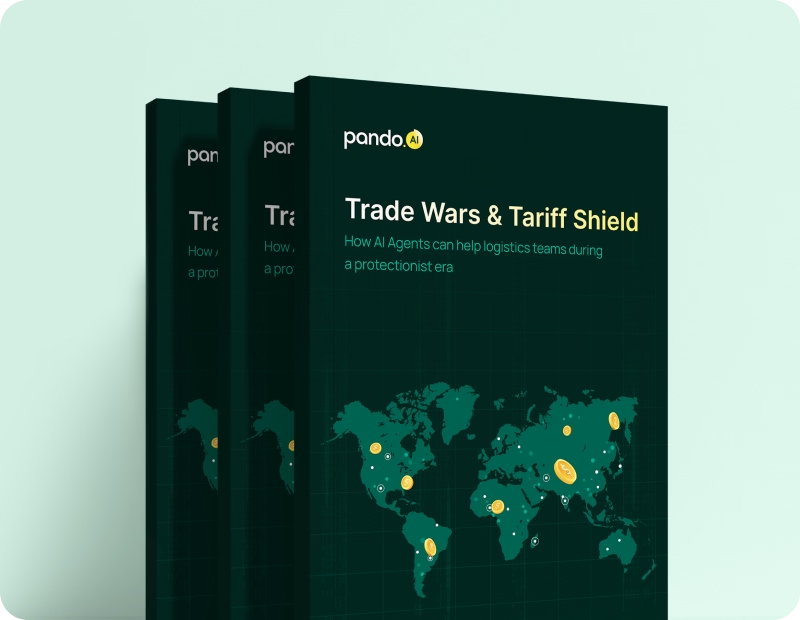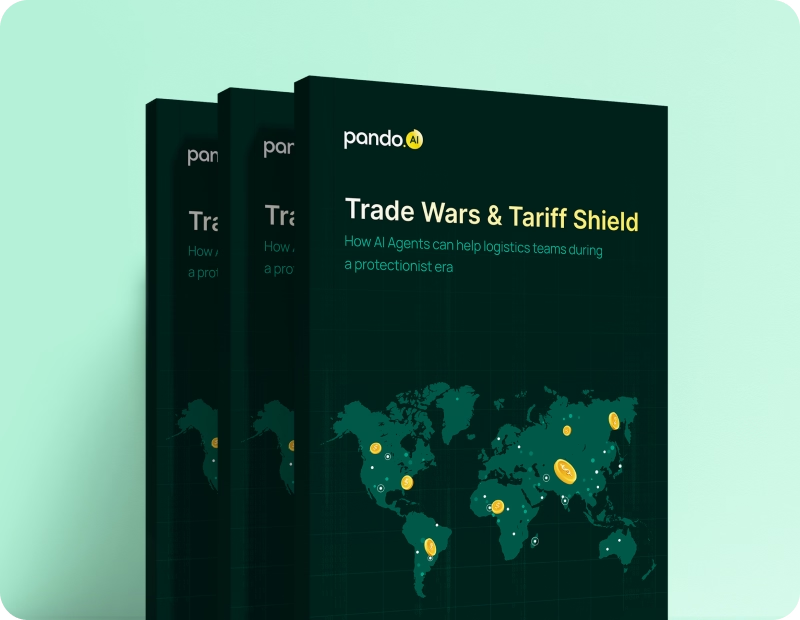-
Products Products
- Industry
- Initiatives
- Resources
- Company
- Book a demo

Before you go: Logistics leaders just dropped the truth on AI
The State of AI in Logistics 2025 is here — no hype, just real conversations and raw insights.
Enhance freight procurement with AI agents for smarter lane selection
See why manual lane selection could be costing you millions in hidden inefficiencies.
Published on December 19, 2024 • 7 mins read
Durga Pratiha

See why manual lane selection could be costing you millions in hidden inefficiencies.
Lane selection in freight procurement is about finding the most efficient and cost-effective routes to move goods—considering factors like shipment volume, carrier performance, and market conditions. It’s key to ensuring timely deliveries and keeping costs in check. But disruptions like port strikes, geopolitical tensions, and rising fuel prices throw a wrench in the works, making it harder to select the right lanes. Outdated systems simply can’t keep up with these challenges, struggling with the lack of intuitive lane bundling or tiered lane support, leaving shippers reacting instead of proactively managing their networks.
At the same time, fluctuating freight rates add another layer of complexity. Without real-time benchmarking tools, shippers are left guessing, often paying more than they should when negotiating contracts. All of this makes it tough to stay ahead.
That’s where AI-driven lane selection steps in. As logistics shifts toward smarter, data-driven strategies, adopting AI tools is becoming essential. This blog will explore how AI agents can help you tackle these challenges, stay competitive, and make better decisions in an ever-changing industry.
The challenges of lane selection in freight procurement
When it comes to freight procurement, selecting the right lanes isn’t always straightforward. The process of lane selection has its fair share of challenges, some of which may seem small at first but can snowball into costly inefficiencies if left unchecked. Let’s take a closer look at some of the common roadblocks that can hinder optimal lane decisions and impact your overall logistics performance.
Manual contract management: Relying on outdated tools like spreadsheets for contract management slows down lane formation and increases the risk of compliance issues. This inefficiency prevents the ability to quickly adjust lanes or renegotiate terms, leading to potential cost overruns and delays in freight operations.
Limited visibility into market rates: Without real-time market rate visibility, shippers lack the insights needed to secure competitive pricing. This often results in instinct-driven decisions, such as locking lanes into long-term contracts, instead of taking advantage of flexible options like mini-bids to drive cost savings.
Fragmented lane bundling strategies: Inefficient grouping of shipments prevents shippers from leveraging economies of scale, leaving money on the table.
Inaccurate volume planning: Poor forecasting and volume allocation result in underutilized or overcommitted lanes, driving up costs and straining carrier relationships.
Lack of intelligent multimodal integration: Traditional systems often fail to coordinate lanes across transport modes like rail, road, and ocean freight, complicating route optimization. This results in inefficiencies and missed opportunities for cost savings.
Reactive disruption management: Without real-time alerts for disruptions like weather events, port congestion, or geopolitical shifts, companies are forced into reactive rather than proactive adjustments.
Why current tech stacks are falling behind in freight procurement?
While existing tech stacks have been instrumental in freight procurement, they are increasingly unable to meet the evolving demands of lane-specific decision-making. These systems often rely on high-level, generalized data like average lane costs but fail to provide actionable insights. They lack the sophistication required to optimize lane selection, such as real-time rate tracking, detailed lane metrics, and predictive analytics customized to unique operational needs.
-
Limited freight-specific analytics
Current systems often fail to offer granular, freight-specific data essential for effective decision-making. Key metrics like lane density, cost-per-mile, and utilization rates are either missing or underdeveloped. Without these insights, shippers rely on manual analysis, which is both error-prone and time-consuming. This leads to inefficiencies that ripple across the supply chain.
-
Basic lane bundling capabilities
Many solutions still in use employ rigid, standardized approaches to lane bundling, failing to adapt to dynamic variables such as shipment frequency, geography, or carrier preferences. This results in inefficient lane groupings, higher costs, and missed opportunities for volume-based discounts. Additionally, inconsistent capacity allocation can strain carrier relationships, further impeding optimization efforts.
-
Outdated lane rate benchmarking
Shippers rely on static rate cards or manual benchmarks provided by the current systems that lack real-time rate comparison features. This makes it difficult for procurement teams to negotiate competitive pricing or secure optimal contracts. The result? Overpayments and lost opportunities for cost savings in an already volatile market.
-
Limited multimodal and tiered lane support
Managing multimodal lanes—those involving road, rail, ocean, or air transport requires seamless integration, something current systems often lack. This inability to optimize complex, tiered operations can lead to higher costs, delays, and inefficiencies, particularly for cross-border logistics where coordination is critical.
-
Reactive disruption management
Most tech stacks provide after-the-fact notifications for disruptions like weather events, port congestion, or geopolitical changes. This reactive approach leaves shippers scrambling to manage issues, rather than preventing them. Without proactive capabilities, delays, cost overruns, and underutilized lanes become unavoidable.
As the limitations of current tech stacks become more evident, businesses are turning to AI-driven solutions to navigate modern freight challenges. By offering dynamic, real-time capabilities, AI agents bring agility, precision, and adaptability to freight procurement, delivering optimized lane selection, cost savings, and resilience in the face of market shifts.
How do AI agents revolutionize lane selection?
Agentic AI refers to advanced artificial intelligence systems that act as autonomous, self-learning agents capable of interacting with complex systems, making informed decisions, and executing actions independently. Unlike predictive AI, which focuses on forecasting outcomes, or generative AI, which creates content or models, Agentic AI adapts to changing conditions, learns from new data, and continuously improves its performance. These AI agents excel in solving intricate, real-world problems, often in dynamic environments like freight procurement.
Let’s break it down. In freight procurement, selecting the right transportation lanes—those paths along which goods are shipped—can make or break efficiency and cost-effectiveness. Traditionally, lane selection has been a manual or semi-automated process, relying on predefined rules and historical data. However, with Agentic AI, this process becomes more intelligent, dynamic, and automated.
Here’s how AI agents are redefining lane selection: 
1. Automated lane formation and streamlined contract management
Transforming manual processes, AI agents analyze expiring contracts to identify compliance risks and cost-saving opportunities. For instance, in a retail store scenario in Texas with a warehouse in Dallas, these agents retrieve transportation contracts, evaluate lane performance, and prepare draft bid events tailored to high-performing carriers. This proactive approach eliminates inefficiencies, ensuring you stay ahead in freight procurement without losing valuable time or resources.
2. Intelligent Lane Bundling
Peak seasons often bring logistical chaos, but intelligent lane bundling simplifies complexity. AI evaluates shipment volumes, regional proximities, and carrier performance to create bundles that maximize backhauls and reduce empty miles. This strategy not only optimizes costs but also strengthens carrier relationships by offering reliable and profitable opportunities. It’s a win-win for logistics efficiency and carrier collaboration.
3. Real-time lane rate benchmarking and market analysis
Real-time benchmarking is a game changer in securing competitive freight rates. AI agents continuously monitor market conditions and compare lane rates against contracts, identifying areas for cost-saving renegotiations. For example, if market rates for a lane drop significantly, the agent flags it, prompting the logistics team to act immediately. This enables businesses to stay agile in volatile markets, protecting their bottom line.
4. Dynamic alerts for disruptions and multi-modal optimization
Logistics thrives on adaptability, and dynamic alerts enable proactive responses to disruptions. From weather forecasts to geopolitical events, AI agents predict risks and recommend adjustments in lane selection or mode of transport. For instance, when port delays arise, the system might suggest rerouting via air freight or exploring alternative multimodal solutions, ensuring timely deliveries despite unforeseen challenges.
5. Smart lane recommendations
Effective lane selection is more than choosing the lowest-cost option; it’s about finding the best fit. AI analyzes historical carrier performance, risk factors, and delivery timelines to recommend lanes that strike the right balance between cost and reliability. For example, while a low-cost lane might seem appealing, AI might highlight delays or risks associated with it, recommending a slightly pricier yet more dependable option. This ensures long-term benefits like service consistency, customer satisfaction, and cost efficiency.
AI in lane selection is not just another technology upgrade
AI-powered lane selection redefines freight procurement by shifting from traditional systems to intelligent, data-driven strategies. With real-time data, predictive analytics, and proactive decision-making, AI eradicates inefficiencies and enhances route optimization, rate benchmarking, and disruption management. It transforms operations into a self-learning system that evolves with market dynamics. This evolution not only reduces manual effort but also empowers procurement teams to make value-focused decisions, fostering resilience, adaptability, and efficiency in the ever-changing logistics landscape.
Pando.ai brings unmatched expertise and cutting-edge solutions to the table. With a proven track record of transforming procurement processes across the freight ecosystem, Pando recognizes that traditional lane selection techniques are no longer sufficient to meet the evolving demands of today’s freight landscape. Basic automation falls short in managing the complexity of modern operations.
AI-driven lane selection, powered by intelligent agents that process real-time data and make dynamic decisions, is the key to enhancing procurement efficiency, agility, and cost-effectiveness. Pando.ai makes AI adoption simple, offering tailored solutions to tackle the specific challenges of lane optimization and delivering results that matter. Don’t let outdated processes hold your organization back—partner with Pando.ai today and transform your procurement strategy for greater efficiency.
Subscribe to Pando blog and Crossroads newsletter now!
Stay up to date with the latest logistics, transportation, and supply chain tips and news.
Subscribe Here!













